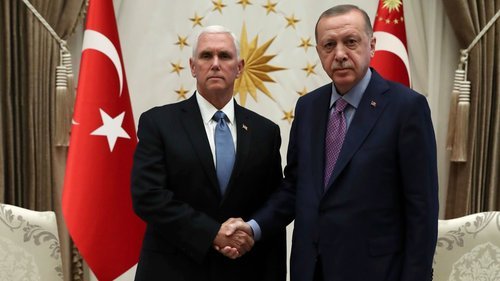‘Ceasefire’ or ‘pause’? Four things to know about the US-Turkey deal in Syria

The US and Turkey announced a five-day break in fighting in Northern Syria today. Referred to as a “ceasefire” by the US and as a “pause” by Turkey, the agreement is unclear about how it would be implemented in one of the most complex battlefields on Earth. Here’s what you need to know.
The significance of 120 hours
The most important detail is that the break will span a 120-hour period between its announcement and a key meeting between the real powerbrokers: Russian president Vladimir Putin (who backs the Syrian government, which recently allied with the Syrian Kurds), and Turkish President Recep Tayyip Erdogan. This is the US trying to make that key meeting in Sochi, Russia, appear to be influenced by Washington.
Where exactly is the safe zone?
The deal requires Kurdish militias to withdraw from a “safe zone,” but that zone hasn’t been properly defined. Both US and Turkey agree it goes 20 miles into Syria. But Turkey says it reaches from the Euphrates River to the Iraqi border — which would include the key Syrian Kurdish cities of Kobani and Qamishli. There was celebratory gunfire in Qamishli after the announcement, suggesting residents there are not too upset or about to expel their SDF forces. And Mike Pence specifically said there would be no military action over Kobani. So that means the signatories to the deal are not clear on where it applies.
It is possible that the US sees the zone as only covering an area that Turkey already primarily controls. Pence mentioned that the US was always in favour of a safe zone, perhaps referring to an earlier, more shallow border buffer zone set up with the Turkish military between the key border towns of Tal Abyad and Ras Al Ain. Apart from bitter fighting still ongoing for Ras Al Ain, Turkish forces control much of the gap between those towns. CNN saw Turkish armor on the main highway about 30 miles inside Syria on Sunday, suggesting the US is talking about a “safe zone” that Turkey mostly already has comfortable control of.
Fighting may not stop everywhere
The agreement doesn’t necessarily stop fighting outside of the safe zone. Pitched battles have happened far deeper into Syria than this zone seems to envelop. It is entirely possible that, in the days ahead, clashes continue around Ain Issa, Tal Tamr and Qamishli — all of which were in Syrian-Kurdish hands, with increased Syrian regime support — but may be considered outside the “zone”.
What about Syrian and Russian forces?
The agreement does not set terms on the Syrian regime or Russian forces. That may be deliberate. Russian forces have already stepped into the former US role of monitoring the Syrian-Kurdish and Turkish borders outside Kobani, physically manning an outpost there with Russian flags in the wind.
Next week’s talks in Sochi may end up establishing the regime and Moscow as security guarantors in areas where Turkey has yet to establish total control, and ensure the Syrian Kurdish military presence is, on the face of it, minimal. This isn’t ideal for Turkey, but it does solidify their substantial land grab of the past week, and may reduce the Syrian Kurdish threat on their southern flank.
But it’s important to remember the real deal isn’t done yet. This is a placeholder to set the table for the true negotiations in Sochi, where Moscow and Ankara will have to agree terms.

